The Impact of Inter-Basin Water Transfer Schemes on Hydropower Generation in the Upper Reaches of the Yangtze River during Extreme Drought Years
Abstract
1. Introduction
2. Materials and Methods
2.1. Study Area
2.2. CLHMS Model
2.3. LSTM-Based Reservoir Operation Simulation Model
2.4. Experimental Design
3. Model Calibration and Validation
3.1. Validation and Calibration of CLHMS Models
3.2. Validation and Calibration of LSTM-Based Reservoir Operation Simulation Model Models
4. Impacts of Reservoir Operation
4.1. Impacts of Water Transfer Scheme 1 on Reservoir Generation
4.2. Impacts of Water Transfer Scheme 2 on Reservoir Generation
4.3. Comparative Analysis of Water Diversion Scheme 1 and Scheme 2
5. Discussion
6. Conclusions
- (1)
- The CLHMS-LSTM model can be used to effectively characterize the hydrological characteristics of the main stem of the Yangtze River. Additionally, it can simulate the reservoir operation well.
- (2)
- Inter-basin water transfer projects decrease hydropower generation of cascade hydropower stations in the Yangtze River.
- (3)
- Comparing two inter-basin water transfer schemes, Scheme 2 was found to reduce the loss of hydropower generation in the Yangtze River cascade hydropower stations without decreasing the total amount of water transferred. Compared to Scheme 1, Scheme 2 could reduce the loss of hydropower generation by 1.38 billion kilowatt-hours.
- (4)
- Comparing the impact of the two inter-basin water transfer schemes on the hydropower generation structure of each power station, both schemes resulted in decreased hydropower generation mainly during the wet season. However, Scheme 2 caused less hydropower generation loss during the dry season compared to Scheme 1, making it more beneficial for addressing the problem of inadequate power supply during the dry season and the greater pressure of hydro peak regulation.
Author Contributions
Funding
Institutional Review Board Statement
Informed Consent Statement
Data Availability Statement
Conflicts of Interest
References
- Lian, X.; Piao, S.; Chen, A.; Huntingford, C.; Fu, B.; Li, L.Z.X.; Huang, J.; Sheffield, J.; Berg, A.M.; Keenan, T.F.; et al. Multifaceted characteristics of dryland aridity changes in a warming world. Nat. Rev. Earth Environ. 2021, 2, 232–250. [Google Scholar] [CrossRef]
- Rajib, A.; Merwade, V. Hydrologic response to future land use change in the Upper Mississippi River Basin by the end of 21st century. Hydrol. Process 2017, 31, 3645–3661. [Google Scholar] [CrossRef]
- Khan, M.D.; Shakya, S.; Vu, H.H.T.; Ahn, J.W.; Nam, G. Water Environment Policy and Climate Change: A Comparative Study of India and South Korea. Sustainability 2019, 11, 3284. [Google Scholar] [CrossRef]
- Zhao, J. Study on the holistic model for water resources system. Sci. China Ser. E 2004, 47, 72–89. [Google Scholar] [CrossRef]
- Tian, J.; Liu, D.; Guo, S.; Pan, Z.; Hong, X. Impacts of Inter-Basin Water Transfer Projects on Optimal Water Resources Allocation in the Hanjiang River Basin, China. Sustainability 2019, 11, 2044. [Google Scholar] [CrossRef]
- Zhou, Y.; Guo, S.; Hong, X.; Chang, F.-J. Systematic impact assessment on inter-basin water transfer projects of the Hanjiang River Basin in China. J. Hydrol. 2017, 553, 584–595. [Google Scholar] [CrossRef]
- Omer, A.; Elagib, N.A.; Zhuguo, M.; Saleem, F.; Mohammed, A. Water scarcity in the Yellow River Basin under future climate change and human activities. Sci. Total Environ. 2020, 749, 141446. [Google Scholar] [CrossRef]
- Dong, N.; Wei, J.; Yang, M.; Yan, D.; Yang, C.; Gao, H.; Arnault, J.; Laux, P.; Zhang, X.; Liu, Y.; et al. Model Estimates of China’s Terrestrial Water Storage Variation Due To Reservoir Operation. Water Resour. Res. 2022, 58, e2021WR031787. [Google Scholar] [CrossRef]
- Hong, X.; Guo, S.; Wang, L.; Yang, G.; Liu, D.; Guo, H.; Wang, J. Evaluating Water Supply Risk in the Middle and Lower Reaches of Hanjiang River Basin Based on an Integrated Optimal Water Resources Allocation Model. Water 2016, 8, 364. [Google Scholar] [CrossRef]
- Gao, Y.Y.; Yao, J.W.; Chen, G.F.; Chen, W.Y. Current situation and prospects of water diversion schemes in China. China Water Resour. 2018, 4, 49–51. [Google Scholar]
- Zhuang, W. Eco-environmental impact of inter-basin water transfer projects: A review. Environ. Sci. Pollut. Res. 2016, 23, 12867–12879. [Google Scholar] [CrossRef] [PubMed]
- Bai, T.; Sun, X.-G.; Wei, J.; Wu, L. Hydrological Response and Ecological Flow Optimization in Water Diversion Area of Inter-basin Water Diversion Project. Water Resour. Manag. 2022, 36, 5839–5865. [Google Scholar] [CrossRef]
- Yang, Y.; Chen, S.; Zhou, Y.; Ma, G.; Huang, W.; Zhu, Y. Method for quantitatively assessing the impact of an inter-basin water transfer project on ecological environment-power generation in a water supply region. J. Hydrol. 2023, 618, 129250. [Google Scholar] [CrossRef]
- Quan, Y.; Wang, C.; Yan, Y.; Wu, G.; Zhang, H. Impact of Inter-Basin Water Transfer Projects on Regional Ecological Security from a Telecoupling Perspective. Sustainability 2016, 8, 162. [Google Scholar] [CrossRef]
- Wu, Y.; Huang, L.; Zhao, C.; Chen, M.; Ouyang, W. Integrating hydrological, landscape ecological, and economic assessment during hydropower exploitation in the upper Yangtze River. Sci. Total Environ. 2021, 767, 145496. [Google Scholar] [CrossRef] [PubMed]
- Wang, Y.; Zhang, N.; Wang, D.; Wu, J.; Zhang, X. Investigating the impacts of cascade hydropower development on the natural flow regime in the Yangtze River, China. Sci. Total Environ. 2018, 624, 1187–1194. [Google Scholar] [CrossRef] [PubMed]
- Sun, S.; Zhou, X.; Liu, H.; Jiang, Y.; Zhou, H.; Zhang, C.; Fu, G. Unraveling the effect of inter-basin water transfer on reducing water scarcity and its inequality in China. Water Res. 2021, 194, 116931. [Google Scholar] [CrossRef]
- Cronin, J.; Anandarajah, G.; Dessens, O. Climate change impacts on the energy system: A review of trends and gaps. Clim. Change 2018, 151, 79–93. [Google Scholar] [CrossRef]
- Panteli, M.; Mancarella, P. Influence of extreme weather and climate change on the resilience of power systems: Impacts and possible mitigation strategies. Electr. Power Syst. Res. 2015, 127, 259–270. [Google Scholar] [CrossRef]
- Schaeffer, R.; Szklo, A.; Frossard Pereira De Lucena, A.; Soria, R.; Chavez-Rodriguez, M. The Vulnerable Amazon: The Impact of Climate Change on the Untapped Potential of Hydropower Systems. IEEE Power Energy Mag. 2013, 11, 22–31. [Google Scholar] [CrossRef]
- Liu, X.; Tang, Q.; Voisin, N.; Cui, H. Projected impacts of climate change on hydropower potential in China. Hydrol. Earth Syst. Sci. 2016, 20, 3343–3359. [Google Scholar] [CrossRef]
- Bloom, A.; Helman, U.; Holttinen, H.; Summers, K.; Bakke, J.; Brinkman, G.; Lopez, A. It’s Indisputable: Five Facts About Planning and Operating Modern Power Systems. IEEE Power Energy Mag. 2017, 15, 22–30. [Google Scholar] [CrossRef]
- Schmidt, B.V.; Wang, Z.; Ren, P.; Guo, C.; Qin, J.; Cheng, F.; Xie, S. A review of potential factors promoting fish movement in inter-basin water transfers, with emergent patterns from a trait-based risk analysis for a large-scale project in china. Ecol. Freshw. Fish 2020, 29, 790–807. [Google Scholar] [CrossRef]
- Tien Bui, D.; Talebpour Asl, D.; Ghanavati, E.; Al-Ansari, N.; Khezri, S.; Chapi, K.; Amini, A.; Thai Pham, B. Effects of Inter-Basin Water Transfer on Water Flow Condition of Destination Basin. Sustainability 2020, 12, 338. [Google Scholar] [CrossRef]
- Bai, T.; Li, L.; Mu, P.; Pan, B.; Liu, J. Impact of Climate Change on Water Transfer Scale of Inter-basin Water Diversion Project. Water Resour. Manag. 2022, 1–21. [Google Scholar] [CrossRef]
- Zhang, J.; Bing, J.; Li, X.; Guo, L.; Deng, Z.; Wang, D.; Liu, L. Inter-basin water transfer enhances the human health risk of heavy metals in the middle and lower Han River, China. J. Hydrol. 2022, 613, 128423. [Google Scholar] [CrossRef]
- Choi, Y.; Ahn, J.; Ji, J.; Lee, E.; Yi, J. Effects of Inter-Basin Water Transfer Project Operation for Emergency Water Supply. Water Resour. Manag. 2020, 34, 2535–2548. [Google Scholar] [CrossRef]
- Yang, N.; Hou, X.; Li, Y.; Zhang, H.; Wang, J.; Hu, X.; Zhang, W. Inter-basin water diversion homogenizes microbial communities mainly through stochastic assembly processes. Environ. Res. 2023, 223, 115473. [Google Scholar] [CrossRef]
- Dong, N.; Guan, W.; Cao, J.; Zou, Y.; Yang, M.; Wei, J.; Chen, L.; Wang, H. A hybrid hydrologic modelling framework with data-driven and conceptual reservoir operation schemes for reservoir impact assessment and predictions. J. Hydrol. 2023, 619, 129246. [Google Scholar] [CrossRef]
- Yang, J.; Wang, B.; Wang, B.; Bao, Q. Biweekly and 21–30-Day Variations of the Subtropical Summer Monsoon Rainfall over the Lower Reach of the Yangtze River Basin. J. Clim. 2010, 23, 1146–1159. [Google Scholar] [CrossRef]
- Yuan, X.; Chen, C.; Lei, X.; Yuan, Y.; Muhammad Adnan, R. Monthly runoff forecasting based on LSTM–ALO model. Stoch. Environ. Res. Risk Assess. 2018, 32, 2199–2212. [Google Scholar] [CrossRef]
- Bakker, B. Reinforcement learning with long short-term memory. Adv. Neural Inf. Process. Syst. 2001, 14. [Google Scholar]
- Landi, F.; Baraldi, L.; Cornia, M.; Cucchiara, R. Working Memory Connections for LSTM. Neural Netw. 2021, 144, 334–341. [Google Scholar] [CrossRef] [PubMed]
- Lin, J.; Ma, J.; Zhu, J.; Cui, Y. Short-term load forecasting based on LSTM networks considering attention mechanism. Int. J. Electr. Power Energy Syst. 2022, 137, 107818. [Google Scholar] [CrossRef]
- Weerakody, P.B.; Wong, K.W.; Wang, G.; Ela, W. A review of irregular time series data handling with gated recurrent neural networks. Neurocomputing 2021, 441, 161–178. [Google Scholar] [CrossRef]
- Rahaman, M.M.; Varis, O. Integrated water management of the Brahmaputra basin: Perspectives and hope for regional development. In Natural Resources Forum; Wiley Online Library: Hoboken, NJ, USA, 2009; Volume 33, pp. 60–75. [Google Scholar]
- Dong, N.; Yang, M.; Wei, J.; Arnault, J.; Laux, P.; Xu, S.; Wang, H.; Yu, Z.; Kunstmann, H. Toward Improved Parameterizations of Reservoir Operation in Ungauged Basins: A Synergistic Framework Coupling Satellite Remote Sensing, Hydrologic Modeling, and Conceptual Operation Schemes. Water Resour. Res. 2023, 59, e2022WR033026. [Google Scholar] [CrossRef]

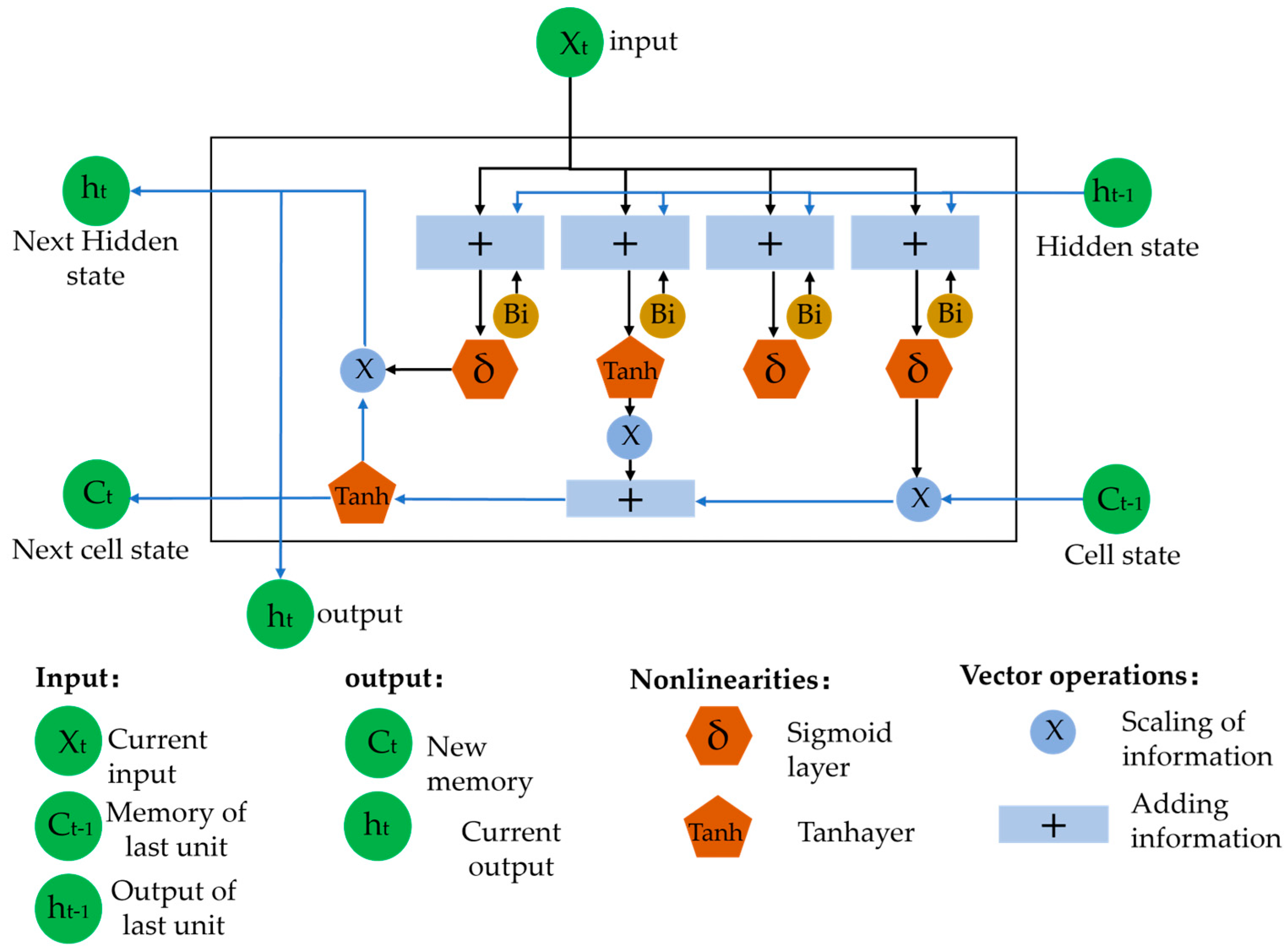
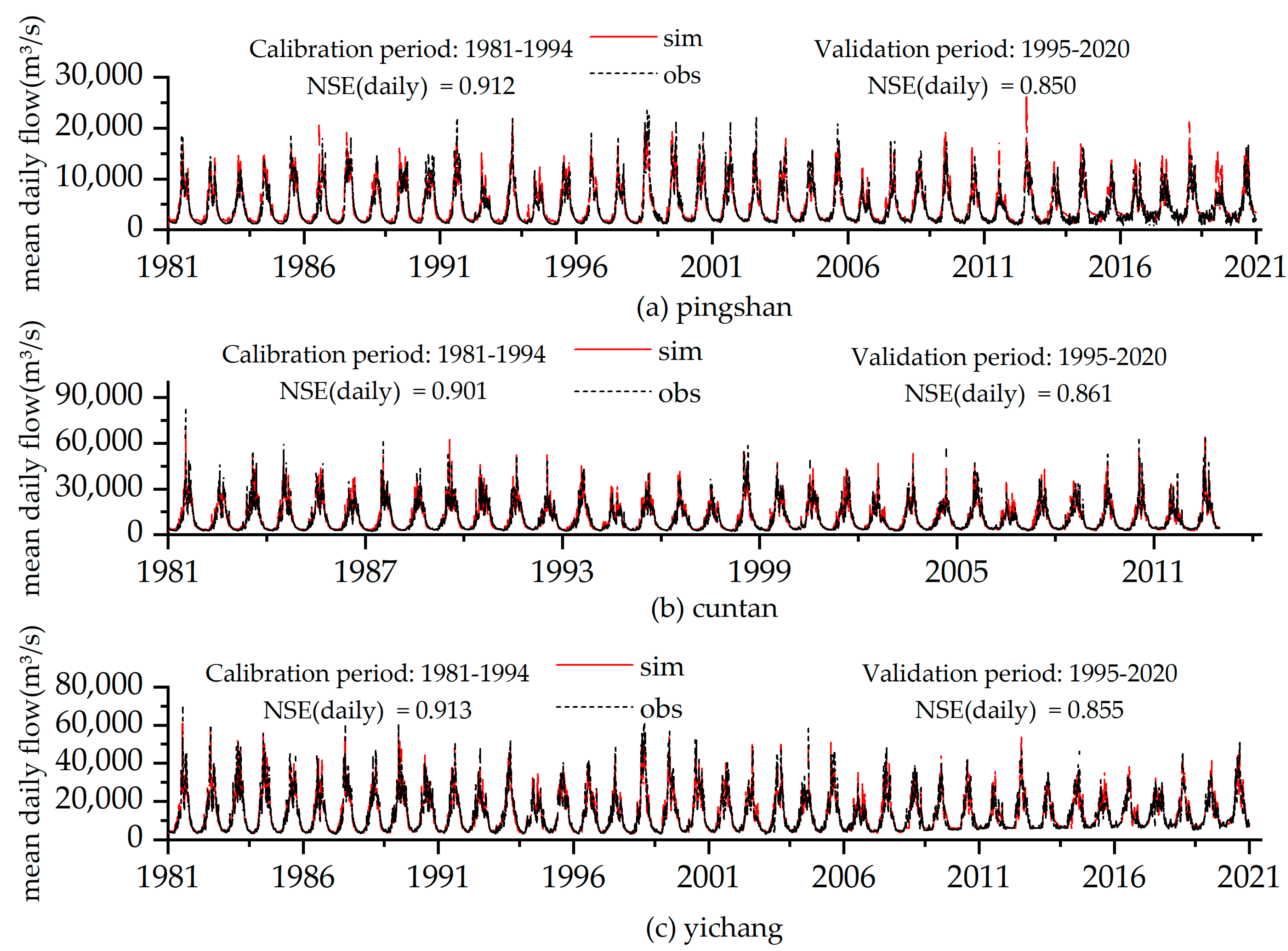
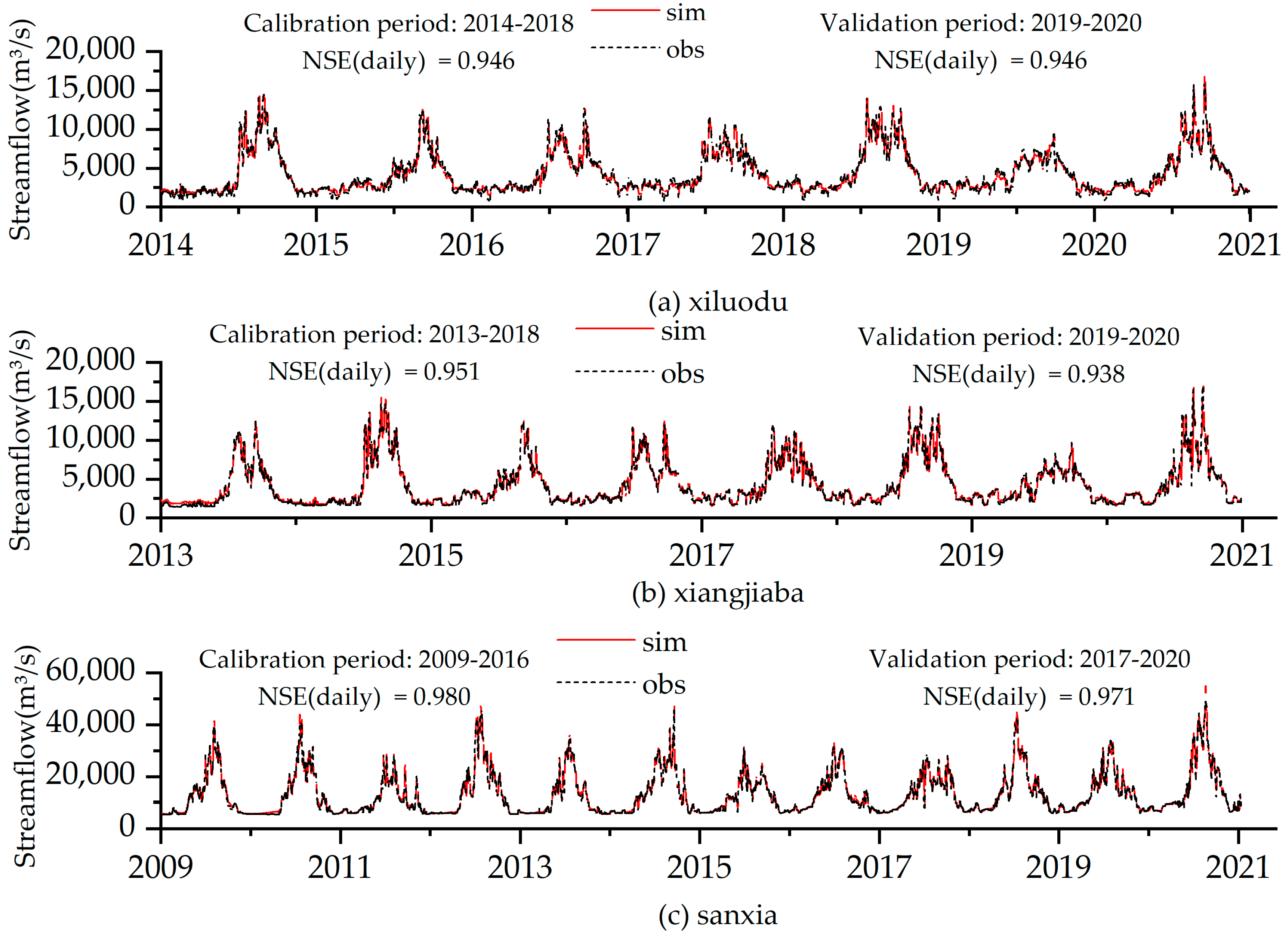
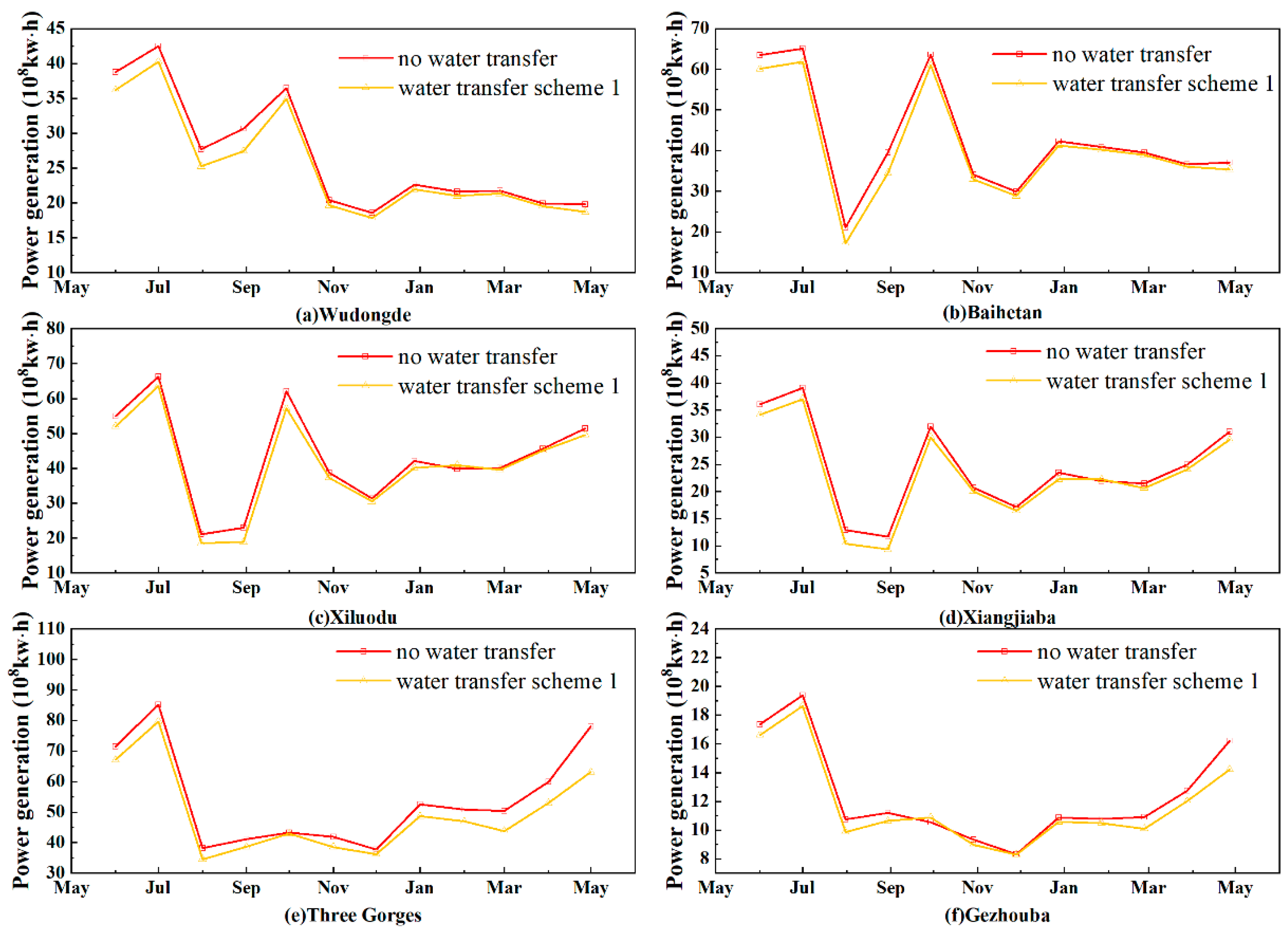
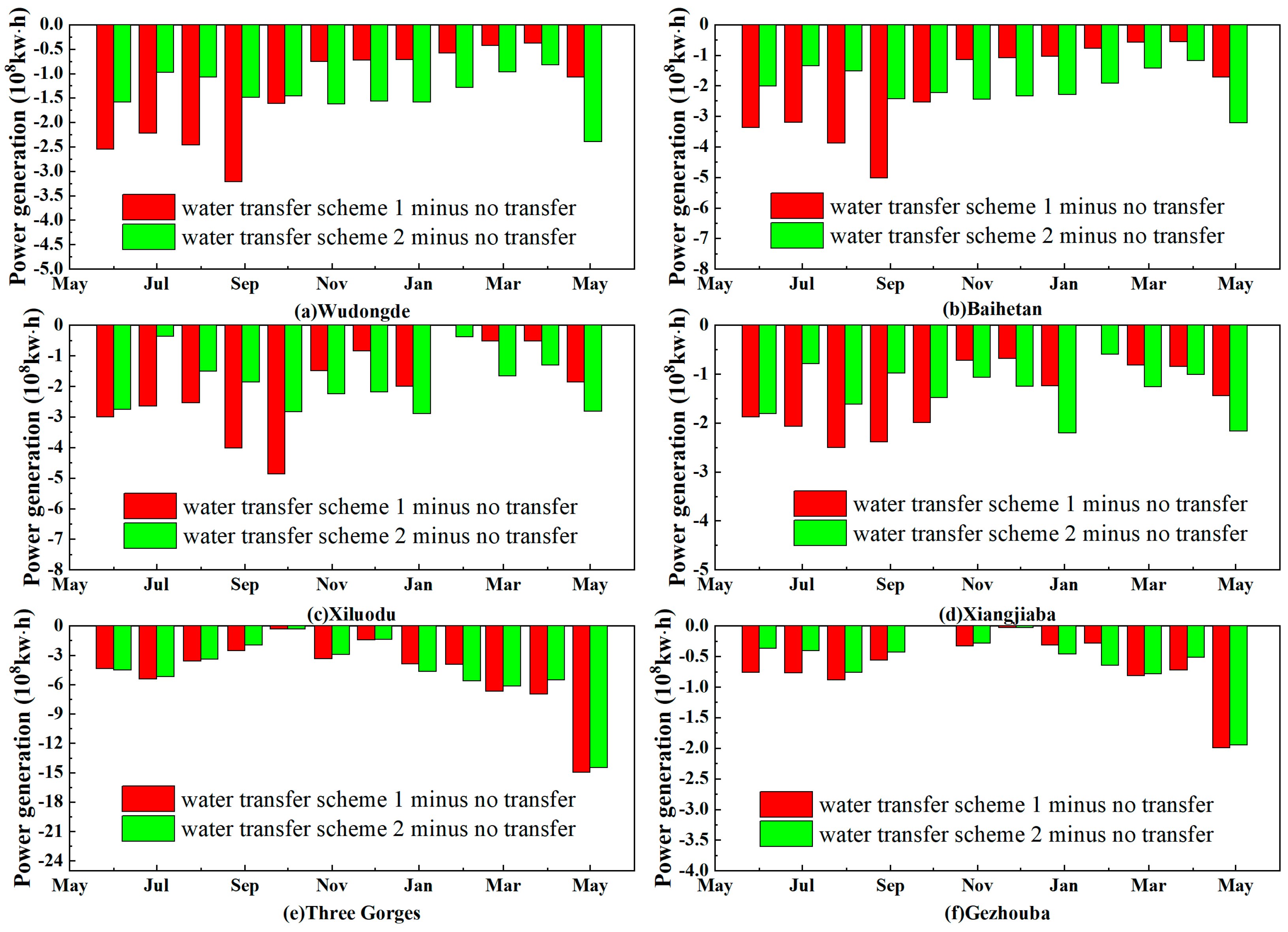
| Reservoir | WDD | BHT | XLD | XJB | SX | GZB |
|---|---|---|---|---|---|---|
| Normal operating level (m) | 975 | 825 | 600 | 380 | 175 | 66 |
| Flood control level (m) | 952 | 785 | 560 | 370 | 145 | 62 |
| Inactive level (m) | 945 | 765 | 540 | 370 | 145 | 62 |
| Flood control storage (108 m³) | 24.4 | 75 | 46.5 | 9.03 | 221.5 | 7.11 |
| Conservation storage (108 m³) | 32.2 | 104.36 | 64.6 | 9.03 | 221.5 | 7.11 |
| Installed capacity (MW) | 10,200 | 16,000 | 13,860 | 6400 | 22,500 | 2735 |
| Project Name | Water Source | Water Receiving Area | Annual Water Diversion Amount (Billion m3) |
|---|---|---|---|
| P1 | Upstream of the Three Gorges Dam | Hubei Provinc | 3.9 |
| P2 | Jinsha River | Honghezhou | 3.403 |
| P3 | Daikosi Reservoir | Gansu Province | 0.96 |
| P4 | Shuangjiangkou | yellow river basin | 8.0 |
| Project Name | Water Diversion Schemes | Water Transfer Scale by Month in Extremely Dry Year (m³/s) | Total | |||||||||||
|---|---|---|---|---|---|---|---|---|---|---|---|---|---|---|
| 1 | 2 | 3 | 4 | 5 | 6 | 7 | 8 | 9 | 10 | 11 | 12 | |||
| P1 | scheme 1 | 99 | 87 | 76 | 104 | 208 | 211 | 171 | 165 | 117 | 105 | 117 | 102 | 1562 |
| scheme 2 | 130 | 130 | 130 | 130 | 130 | 130 | 130 | 130 | 130 | 130 | 131 | 131 | 1562 | |
| P2 | scheme 1 | 16 | 16 | 17 | 15 | 21 | 15 | 22 | 24 | 20 | 15 | 16 | 16 | 215 |
| scheme 2 | 18 | 18 | 18 | 18 | 18 | 18 | 18 | 18 | 18 | 18 | 18 | 17 | 215 | |
| P3 | scheme 1 | 0 | 0 | 0 | 14 | 40 | 52 | 61 | 41 | 35 | 30 | 23 | 4 | 299 |
| scheme 2 | 25 | 25 | 25 | 25 | 25 | 25 | 25 | 25 | 25 | 25 | 25 | 24 | 299 | |
| P4 | scheme 1 | 115 | 120 | 130 | 190 | 329 | 369 | 315 | 282 | 171 | 118 | 112 | 110 | 2359 |
| scheme 2 | 197 | 197 | 197 | 196 | 196 | 196 | 196 | 196 | 197 | 197 | 197 | 197 | 2359 | |
| Reservoir Number | WDD | BHT | XLD | XJB | SX | GZB | Total | |
|---|---|---|---|---|---|---|---|---|
| Before water diversion | wet period | 196.5 | 286.8 | 266 | 152.6 | 321.2 | 78.6 | 1301.7 |
| dry period | 137.9 | 250.2 | 273 | 156.2 | 371.2 | 79.3 | 1267.8 | |
| Total | 334.4 | 537 | 539 | 308.8 | 692.4 | 157.9 | 2569.5 | |
| After water diversion | wet period | 188.3 | 274.8 | 254.5 | 144.9 | 302.9 | 75.8 | 1241.2 |
| dry period | 128.5 | 236.6 | 260.8 | 146.5 | 331.6 | 74.7 | 1178.7 | |
| Total | 316.8 | 511.4 | 515.3 | 291.4 | 634.5 | 150.5 | 2419.9 | |
| Power loss | wet period | 8.2 | 12 | 11.6 | 7.7 | 18.3 | 2.8 | 60.6 |
| dry period | 9.4 | 13.6 | 12.2 | 9.7 | 39.6 | 4.7 | 89.2 | |
| Total | 17.6 | 25.6 | 23.8 | 17.4 | 57.9 | 7.5 | 149.8 | |
| Reduced per-centage | wet period | 4.19% | 4.18% | 4.34% | 5.07% | 5.70% | 3.52% | 27.00% |
| dry period | 6.81% | 5.43% | 4.48% | 6.20% | 10.67% | 5.87% | 39.46% | |
| Total | 11.00% | 9.61% | 8.82% | 11.27% | 16.37% | 9.39% | 66.46% | |
| Reservoir Number | WDD | BHT | XLD | XJB | SX | GZB | Total | |
|---|---|---|---|---|---|---|---|---|
| Before water diversion | wet period | 196.5 | 286.8 | 266 | 152.6 | 321.2 | 78.6 | 1301.7 |
| dry period | 137.9 | 250.2 | 273 | 156.2 | 371.2 | 79.3 | 1267.8 | |
| Total | 334.4 | 537 | 539 | 308.8 | 692.4 | 157.9 | 2569.5 | |
| After water diversion | wet period | 192.3 | 280.6 | 260.7 | 147.1 | 285.6 | 74.2 | 1240.5 |
| dry period | 127.1 | 234 | 257.5 | 145.6 | 351.5 | 77.4 | 1193.1 | |
| Total | 319.4 | 514.6 | 518.2 | 292.7 | 637.1 | 151.6 | 2433.6 | |
| Power loss | wet period | 4.2 | 6.2 | 5.3 | 5.5 | 35.6 | 4.4 | 61.2 |
| dry period | 10.8 | 16.2 | 15.6 | 10.6 | 19.6 | 2 | 74.8 | |
| Total | 15 | 22.4 | 20.9 | 16.1 | 55.2 | 6.4 | 136 | |
| Reduced per-centage | wet period | 2.15% | 2.15% | 2.00% | 3.58% | 11.09% | 5.65% | 26.62% |
| dry period | 7.84% | 6.46% | 5.70% | 6.76% | 5.29% | 2.49% | 34.54% | |
| Total | 9.99% | 8.61% | 7.70% | 10.34% | 16.38% | 8.14% | 61.16% | |
| Water Transfer Schemes | Power Generation after Water Transfer (10⁸ KW·h) | Loss of Generation Compared to No Water Transfer (10⁸ KW·h) | Reduction Compared to No Water Transfer | ||||||
|---|---|---|---|---|---|---|---|---|---|
| Wet Period | Dry Period | Total | Wet Period | Dry Period | Total | Wet Period | Dry Period | Total | |
| 1 | 1241.2 | 1178.7 | 2419.8 | 60.6 | 89.1 | 149.7 | 4.65% | 7.03% | 5.83% |
| 2 | 1240.5 | 1193.1 | 2433.6 | 61.2 | 74.7 | 135.9 | 4.70% | 5.89% | 5.29% |
Disclaimer/Publisher’s Note: The statements, opinions and data contained in all publications are solely those of the individual author(s) and contributor(s) and not of MDPI and/or the editor(s). MDPI and/or the editor(s) disclaim responsibility for any injury to people or property resulting from any ideas, methods, instructions or products referred to in the content. |
© 2023 by the authors. Licensee MDPI, Basel, Switzerland. This article is an open access article distributed under the terms and conditions of the Creative Commons Attribution (CC BY) license (https://creativecommons.org/licenses/by/4.0/).
Share and Cite
Wen, F.; Yang, M.; Guan, W.; Cao, J.; Zou, Y.; Liu, X.; Wang, H.; Dong, N. The Impact of Inter-Basin Water Transfer Schemes on Hydropower Generation in the Upper Reaches of the Yangtze River during Extreme Drought Years. Sustainability 2023, 15, 8373. https://doi.org/10.3390/su15108373
Wen F, Yang M, Guan W, Cao J, Zou Y, Liu X, Wang H, Dong N. The Impact of Inter-Basin Water Transfer Schemes on Hydropower Generation in the Upper Reaches of the Yangtze River during Extreme Drought Years. Sustainability. 2023; 15(10):8373. https://doi.org/10.3390/su15108373
Chicago/Turabian StyleWen, Fan, Mingxiang Yang, Wenhai Guan, Jixue Cao, Yibo Zou, Xuan Liu, Hejia Wang, and Ningpeng Dong. 2023. "The Impact of Inter-Basin Water Transfer Schemes on Hydropower Generation in the Upper Reaches of the Yangtze River during Extreme Drought Years" Sustainability 15, no. 10: 8373. https://doi.org/10.3390/su15108373
APA StyleWen, F., Yang, M., Guan, W., Cao, J., Zou, Y., Liu, X., Wang, H., & Dong, N. (2023). The Impact of Inter-Basin Water Transfer Schemes on Hydropower Generation in the Upper Reaches of the Yangtze River during Extreme Drought Years. Sustainability, 15(10), 8373. https://doi.org/10.3390/su15108373






